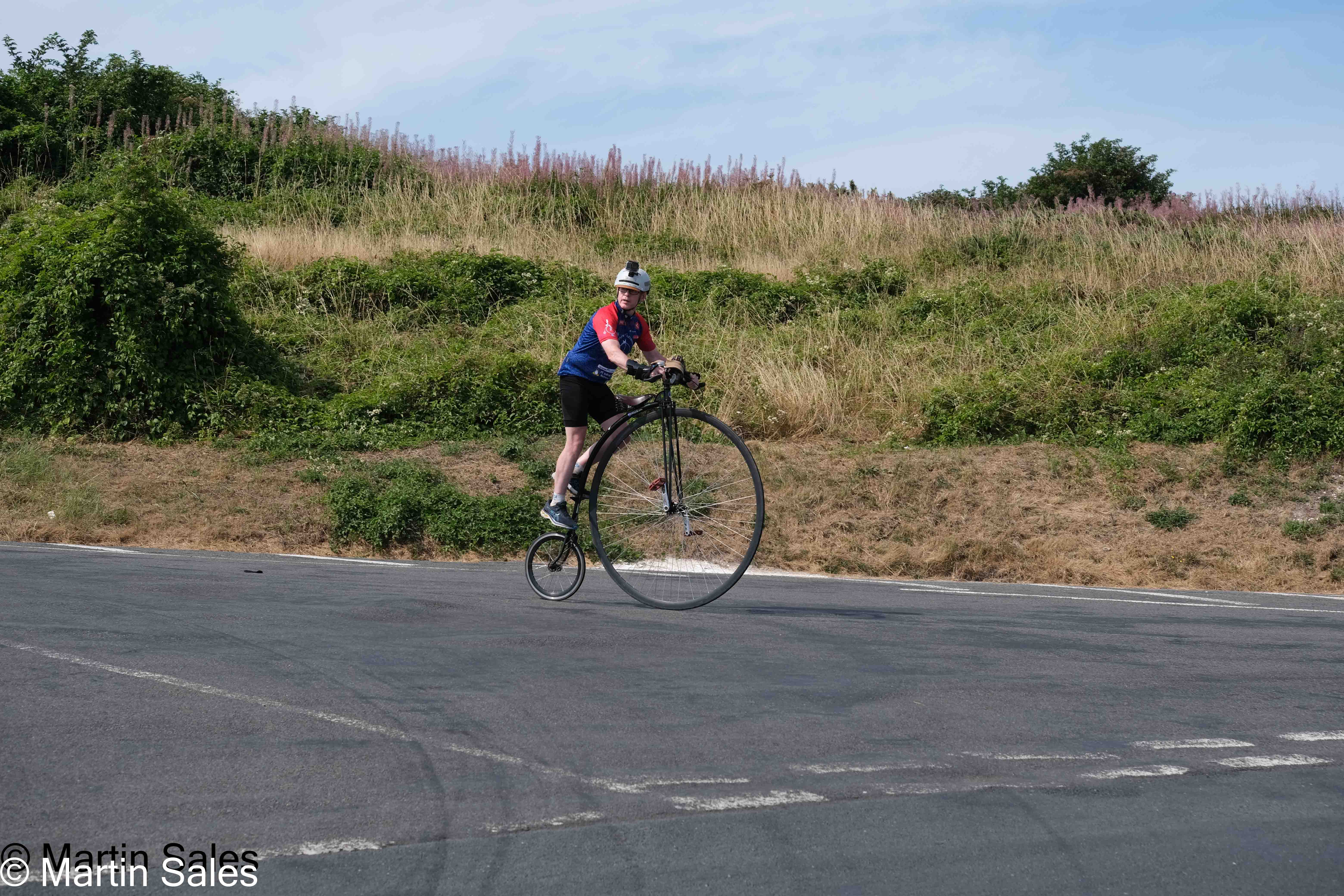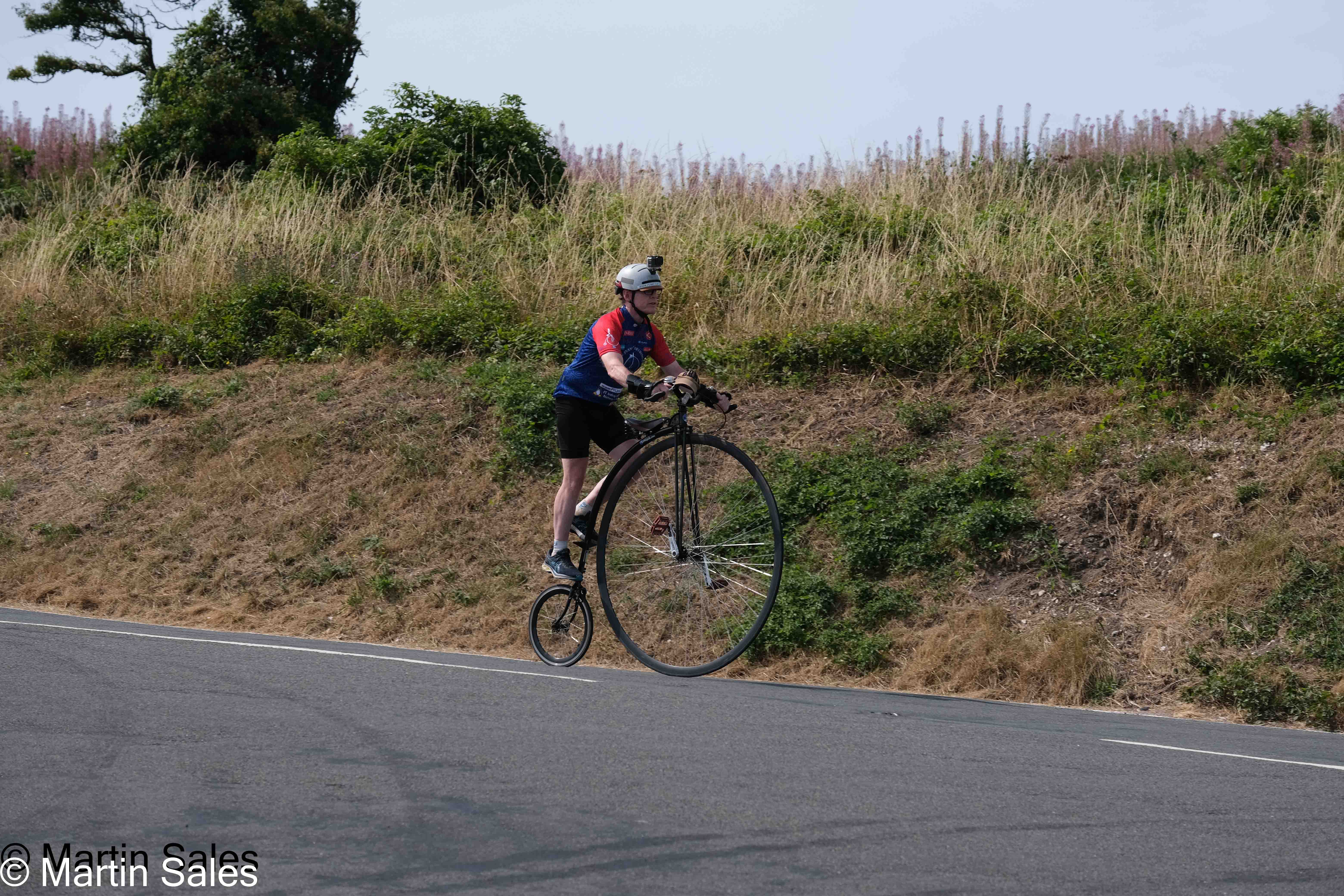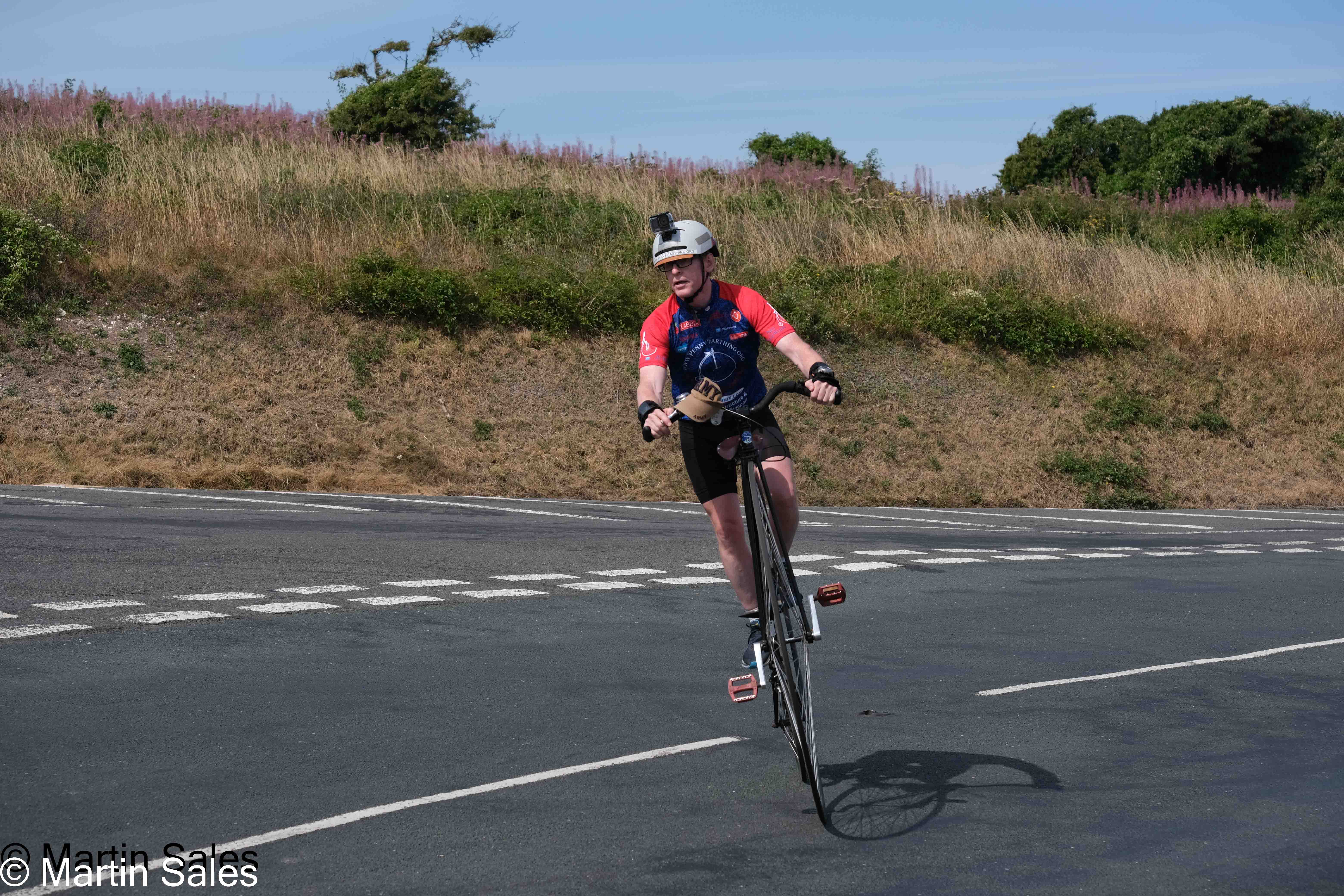
Directional Changes ALWAYS Incur Risk!
Riding a Penny-Farthing in a straight line with no junctures/roundabouts isn’t very difficult. The risk of a serious accident really presents when merging into, or passing in front of, fast traffic making a turn. Approachiing every roundabout juncture the question you must both ask & answer is: Can I safely join the flow of traffic or do I need to dismount?
But even dismounting entails a risk: you need to always be aware of trailing motorists who could mow you down from behind if you surprise them with an abrupt stop.

Yielding Right-of-Way: Don’t Be the Rightest Guy in the Cemetery!
Yield right of way to aggressive/inattentive motorists even if you have the right-of-way. Or don’t and be the “rightest” person in the cemetery…
Approaching Junctures/roundabouts: (6) Key Procedures
1. LOOK!
When assessing traffic flow, be as equally aware of trailing motorists as you are approaching motorists. And don’t rely on only sound to inform you of the presence of trailing road users- LOOK over your shoulder!!! Cyclists & electric vehicles can be trailing quietly behind you. Pro Tip: Where I can see it’s safe for trailing motorists to pass me, I wave my arm in a circular fashion to invite them to do so when approaching a juncture or roundabout. If I can clear the risk posed by trailing motorists, I can be then be more focused on the risks in front of me.
But also be aware of the risk you present to pedestrians when turning: Don’t be so fixated on traffic that you’re not paying attention to the sidewalk for pedestrians, wheelchairs or even the blind who might cross in front of you on the road that you’re turning onto! Making directional changes really requires extra vigilance.
2. Signalling Direction Changes: NOT Optional!
Even is you see there is nobody either/both trailing or approaching you, The Highway Code requires ALL road users to signal directional changes. In addition to hand signals, I STRONGLY advise using electronic turn signals as these will continue to announce your directional intent even when both hands are planted on the handle bars. See the gear section of this site for the “Blinxi” helmet turn signals.
3. Correct Lane Position
If turning RIGHT, move to the INSIDE of the lane to avoid a trailing motorist colliding into you as they pass on the inside of the lane! And if you don’t occupy the inside of the lane, I guarantee some rude motorist will ignore your signal and ram in the space creating a dangerous situation.
4. Pace Your Approach
As you approach a juncture or roundabout, adjust your speed to enable you to merge into traffic safely. If traffic is too busy, then slow-pedal waiting for an appropriate gap allowing you to merge safely. Dismounting & re-mounting in busy traffic is to be avoided wherever possible. Thus, being able to slow-pedal- pedalling so slow that you’re only going fast enough to stay upright– is a just as key skill for a Penny-Farthing cyclist as mounting & dismounting. Correspondingly, if you see that a gap in traffic sufficient to allow you to join the flow of traffic safely, then pedal faster, but also monitoring the sidewalk for pedestrians which could potentially cross in front of you.
5. Blind Junctures: Approach Half-Mounted
When approaching a blind juncture or roundabout on level or downward sloping ground, approach on your peg(s) (“Half-Mounted”) while continuously assessing traffic flow & pedestrians. If it’s safe to join the flow of traffic, re-mount the saddle and pedal. If it’s NOT, since you’re half-mounted, it’s easy to just step onto the ground and halt. Wait and then re-mount and join the traffic when a gap in the flow makes it safe to do so. If you look at the picture below, you can see the benefit of electronic turn signals on your helmet when your hands are planted on the handlebars when cycling half mounted. What if a trailing motorist now appears after I hand signalled and placed my hands back on the handlebars? How can they be certain of my directional intent without electronic signals? They can’t. Any confusion over where your going with other road users, you the cyclist suffer the consequences. My signals in this picture are integrated into the helmet.

6. Don’t Make Sharp Turns
If beginning the turn Half-Mounted because of an obstructed view, continue it half-mounted carving a gentle & wide turn being prepared to step down and halt if necessary if pedestrians, potholes or other hazards present on the other side of the turn. Notice my fingers on the rear calliper brake: I periodically give it a short squeeze and immediately release it to moderate my speed.
If turning mounted on the saddle, the faster and sharper the turn, the more likely that you’re going to go over the handlebars.
If environmental factors are such that there’s no avoiding a sharp turn- I have one from a very busy main road onto a tiny country lane on my daily ride– then slow down to a crawl and lean back to counterbalance. And never forget that dismounting and walking is always an option until you have the experience to judge your ability to join traffic traffic safely under various conditions.

In the below video, you can see me approach the blind roundabout on my mount pegs while moderating the speed with my rear calliper brake. I remark as I approach that a car already in the roundabout and passing in front of the car to my immediate right enabling me to join the the flow of traffic safely. So although I can’t see approaching traffic very clearly, logically I know that even were they, the car passing in front of vehicles to my right will block them for me.
Note that I don’t re-mount the saddle until I have a clear view of the traffic- and pedestrians- in front of me on the road I’m joining. Also note the perspective of the videographer joining the roundabout. This gives you a first-person perspective of the challenges of changing direction at a busy roundabout and why it’s so important that you master the skill of mounting & dismounting before venturing out on to busy roads.
Turning Right: Turning Across On-Coming Traffic
Here in the UK, turning RIGHT means passing in front of traffic in the opposite lane. It’s so important that you keep your head constantly swivelling and be prepared to halt if you cannot pass in front of on-coming traffic with a safe margin in front of approaching vehicles.
Turning Left: Your Ace-in-the Hole
Let’s say you do everything right: you moderate your speed, you swivel your head constantly assessing the road & sidewalks for hazards and it looks OK to enter the roundabout or juncture and then some speeding lunatic appears. What do you do?
If a speeding motorist will make it unsafe to pass through a juncture or enter a roundabout, check nobody- even fellow cyclists- are passing on your inside and guide tightly to the edge of the road allowing you to turn left to avoid passing in front of the approaching motorist. It’s obviously better to make a complete halt, but if we’re on the cusp of entering the juncture when Mr. Speeding Lunatic Guy changed the dynamics, turning left is now the least bad option. Just reverse direction at the next roundabout and continue on your intended path.
BUT: Turning left is only possible if there are no pedestrians, wheelchairs or blind folks who look like they’re about to cross in front of us when turning! Always monitor the sidewalk when approaching a juncture or roundabout!
